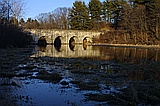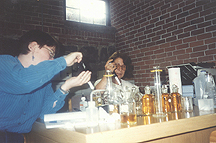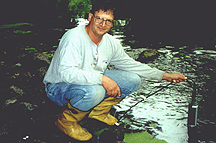Organization for the Assabet River
Damonmill Square
Concord, MA 01742
Tel: 978-369-3956
Email: oar@assabetriver.org
|
Water Quality |
 |
| |
|
| Reports | What do we test | General Findings | How to interpret the data |
| OAR's Water Quality Monitoring Program | ||||||||||||||||||||||||||||||||||||
 |
In 1992, OAR started a testing water quality to evaluate the impact of wastewater treatment plant upgrades completed in the late 1980s. OAR volunteers have tested water quality every summer since 1992. Over the years, we have updated our methods, improved our data handling, and increased the number of sampling sites. In April 2000 the EPA approved OAR’s sampling methods as documented in the program’s Quality Assurance Program Plan (QAPP). In 2002, OAR added streamflow and water quality monitoring on the major tributaries to the Assabet River with the StreamWatch Project. Today OAR tests water quality at 15 mainstem sites distributed from the headwaters of the Assabet River in Westborough to the end of the Concord River in Lowell. (View map) Water quality data and reports are available below and on the StreamWatch page (for each tributary stream). |
|||||||||||||||||||||||||||||||||||
|
During the last decade OAR's monitoring program has helped to raise awareness of the Assabet's nutrient problem, pointed to the need for stricter phosphorus limits in the wastewater treatment plant's NPDES permits, made a strong case for the Total Maximum Daily Loading (TMDL) study, and indicated the need for a groundwater model of the Assabet watershed. Water quality and flow data collected under OAR's EPA-approved QAPP may be used by EPA and DEP in making regulatory decisions. |
 |
|||||||||||||||||||||||||||||||||||
|
|
||||||||||||||||||||||||||||||||||||
| WQ
Program Reports Right click to download OAR's complete water quality reports (in pdf format): |
||||||||||||||||||||||||||||||||||||
| What
do we test? OAR's monitoring program focuses on a set of interrelated chemical and physical parameters that can be directly measured in the river. These parameters are also among those used by the Mass DEP for setting water quality standards and regulating discharge permits for wastewater discharge (NPDES permits). |
||||||||||||||||||||||||||||||||||||
|
Dissolved Oxygen
|
||||||||||||||||||||||||||||||||||||
|
Phosphorus (total and ortho-)
|
||||||||||||||||||||||||||||||||||||
|
Nitrogen (NO3, NH3, and TKN)
|
||||||||||||||||||||||||||||||||||||
|
Solids (total suspended)
|
||||||||||||||||||||||||||||||||||||
|
pH
|
||||||||||||||||||||||||||||||||||||
|
Water temperature
|
||||||||||||||||||||||||||||||||||||
|
Streamflow
|
||||||||||||||||||||||||||||||||||||
|
General Findings: |
||||||||||||||||||||||||||||||||||||
 |
Nutrient Saturation in the Mainstem Assabet In the upper sections of the river (where dilution of the wastewater treatment plant effluent by natural flow is the least) nutrient concentrations are well above the thresholds for eutrophication for both phosphorus and nitrogen species. In the lower reaches of the river (below Rte 62 in Stow) nutrient concentrations, although still elevated, are lower than in the upstream sections. Downstream concentrations may be lower |
|||||||||||||||||||||||||||||||||||
|
because: (1) the proportion of natural flow to effluent is larger (more tributaries have joined the mainstem); (2) nutrients are taken up by aquatic plants during the growing season; (3) and particle-bound nutrients are deposited to the sediments in the slow-moving river sections. To support fish and other aquatic life dissolved oxygen concentrations
in the river need to be above 5.0 mg/L or 60% saturation (the state's
warm water Class B standard) and below about 170% saturation. Plants
generate oxygen as a by-product of photosynthesis during the day,
and take oxygen back out of the water column as they respire at
night. So, when there are heavy growths of aquatic plants, dissolved
oxygen concentrations can change dramatically over the day. Dissolved
oxygen at sites all along the river fall below 5.0 mg/L at times
during the summer. |
 |
|||||||||||||||||||||||||||||||||||
| Healthier
Tributaries Water quality, as measured in 2002, in the Assabet headwater (upstream of the first wastewater treatment plant discharge) and in tributary streams of the watershed was generally better than in the mainstem. Phosphorus concentrations were lower than in the mainstem, and dissolved oxygen levels were mainly healthy. The only problems that we observed in 2002 were high phosphorus and low dissolved oxygen concentrations measured at two sites just downstream of beaver dams. Total nitrogen concentrations in the tributaries, although lower than in the mainstem, ranged from healthy to somewhat elevated (> 0.75mg/L). Nutrients in the tributaries are mainly from non-point sources such as stormwater runoff from roads and lawns or failing septic systems. |
||||||||||||||||||||||||||||||||||||
|
How to interpret the data |
||||||||||||||||||||||||||||||||||||
|
Water quality measurements can be compared with:
|
||||||||||||||||||||||||||||||||||||
Page updated: January 2005 (send comments to sflint@assabetriver.org)
